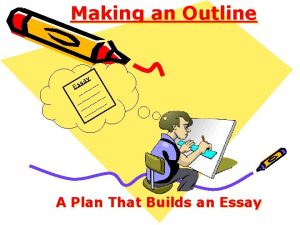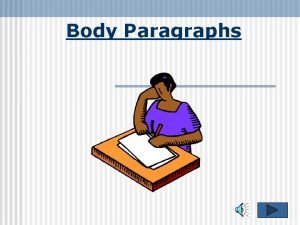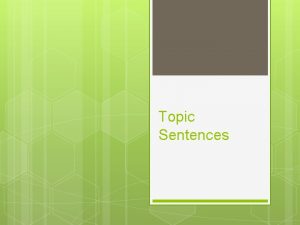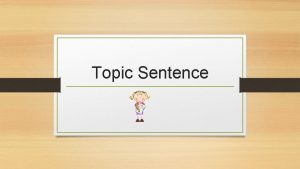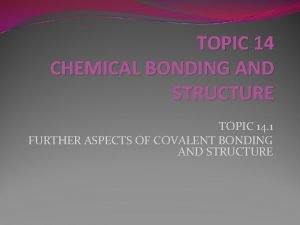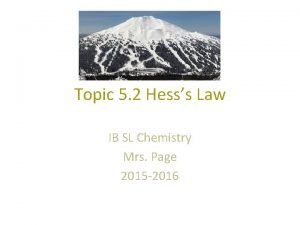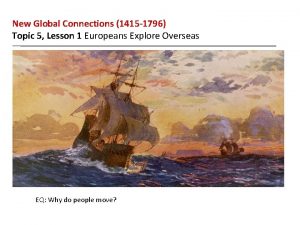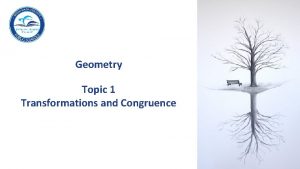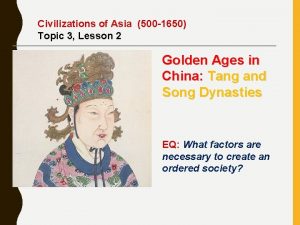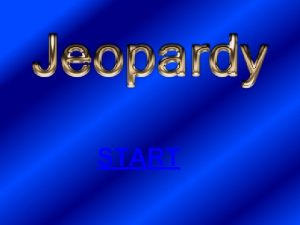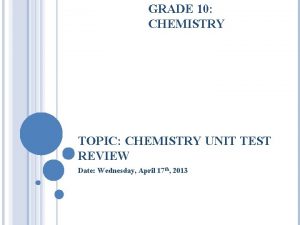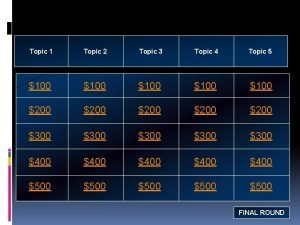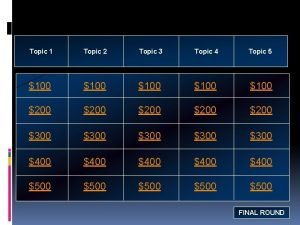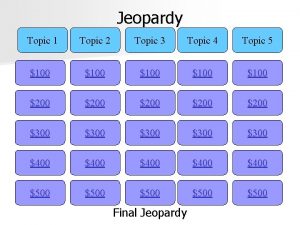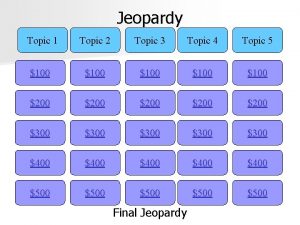GRADE 10 CHEMISTRY TOPIC GRADE 9 REVIEW START

















- Slides: 17

GRADE 10: CHEMISTRY TOPIC: GRADE 9 REVIEW & START OF GRADE 10 MATERIAL Date: Tuesday, March 19 th, 2013

ELEMENT OF THE DAY

ELEMENT OF THE DAY: HELIUM Atomic Number: 2 2 Proton, 2 Electron Atomic Weight: 4. 002602 Location: Group 18 � Nobel Gas � Very stable gas � Non flammable replaced Hydrogen in airships Helium: � Helios – Greek God of Sun � Remember, 600 million tons of hydrogen is converted into helium every second!

ELEMENT OF THE DAY: HELIUM Helium Video: � Watch until 3: 39: � http: //www. youtube. com/watch? v=a 8 FJEi. I 5 e 6 Q

LESSON OVERVIEW Jeopardy Game Grade 10 Introductory Experiment Chemical Reactions Video Extra Help with Ionic Bonds

JEOPARDY FOR GRADE 9 REVIEW Rules � Two teams � The team that asked the question continues until the other team steals. � If the team answers correctly, they get the allotted points. � If the team answers incorrectly, they lose the allotted points. � Teams cycle through until all questions have been answered. � Stealing in this game is encouraged! � Surprise for the winning team!

GRADE 10 INTRODUCTORY EXPERIMENT Experiment: Mixing Baking Soda, Citric Acid, and Water to see the reaction Chapter 4 Power Point – slide 13 ON Science 10 Textbook – page 137 Students will work in their row/pod groups and given the following roles: � 1: Reading the instructions � 1: Gathering the materials � 1 -2: Pouring the materials � 1: Recording observations � Optional: Group leader to keep group on track & to help clean up

GRADE 10 INTRODUCTORY EXPERIMENT Make a hypothesis about what will happen � Observations � � Our group believes _______ will happen because _______________________. Record everything that happens Examples: Colour, time reaction takes, what is formed, texture, consistency, etc. What type of reaction was it? How do you know it was this type of reaction? Make your conclusions & relate back to what you know about physical and chemical reactions (from grade 9 review) **Put all group members’ names on your lab report and hand in for communication marks.

EXPLANATION OF EXPERIMENT What happened? ? � Reaction absorbed heat bag feels cold Endothermic Reaction Absorbing heat from your hand, which makes your hand feel cold � Balanced Formula for Chemical Reaction Occurring: � Carbon Dioxide (CO 2) gas was formed and bubbles H 3 C 6 H 5 O 7(aq) + 3 Na. HCO 3(s) → 3 CO 2(g) + 3 H 2 O(l) + Na 3 C 6 H 5 O 7(aq) Summarizing what happens: Don’t need sound! � http: //www. youtube. com/watch? v=b. PSy 5 Nk. Pk. Jk �

CHEMICAL REACTIONS VIDEO Bill Nye Video: Chemical Reactions � http: //www. youtube. com/watch? v=Plwuxp. Mh 8 nk

FORMING IONIC COMPOUNDS Extra Help with Forming Ionic Compounds: � Review � What is an ionic bond? � Physical Properties � Common Ionic Bonds � http: //www. education. uoit. ca/lordec/ID_LORDEC/ionic_c ompounds/law_ionic_compounds. swf

SUPPORTING DOCUMENTS ON Science 10 Textbook � Pages: 134 -135, 137 Chapter 4 Power Point for ON Science 10 � Slides: 3 -13 Interactive Videos: ‘Subatomic Particles and Isotopes’ Chapter 4 Notebook - pages 3 -7 Websites: http: //www. education. uoit. ca/lordec/ID_LORDEC/ionic_compoun ds/law_ionic_compounds. swf

HOMEWORK ON Science 10 Textbook � Page #: 134 -135 � Questions: 1 -8

HOMEWORK ANSWERS 1. � a. element � b. compound � c. metal � d. valence � e. ion 2. Example:

HOMEWORK ANSWERS 3. � a. Be � b. 2 � c. 4 � d. 4 � e. 4 � f. 5 4. � a. physical property, qualitative (words, descriptions) � b. chemical property � c. physical property, quantitative (numbers, concrete) � d. chemical property

HOMEWORK ANSWERS 5. � a. 1) potassium and chlorine, 2) oxygen and hydrogen � b. Compound 1 is ionic since an electron is transferred between atoms, and compound 2 is covalent since the atoms share electrons. � c. 1) potassium chloride, KCl, 2) dihydrogen monoxide (water), H 2 O 6. The yellow spheres need to be equal on both sides (e. g. , two more yellow spheres on the right/product side).

HOMEWORK ANSWERS 7. Aluminum, 13 � density = mass/volume � = 10/1. 12 � = 8. 93 8. Example: Three facts—red water caused by nickel tailings that contain iron; mining pollution killed vegetation around Sudbury; chemicals helped rehabilitate the area
 Chemistry review grade 10
Chemistry review grade 10 If you gotta start somewhere why not here
If you gotta start somewhere why not here Jump start triage
Jump start triage What is an expository passage
What is an expository passage Step up to writing
Step up to writing Topic outline example
Topic outline example Body sentence in a paragraph
Body sentence in a paragraph Topic sentence example
Topic sentence example What is the topic sentence
What is the topic sentence General subject example
General subject example Narrow topic examples
Narrow topic examples Topic 14 ib chemistry
Topic 14 ib chemistry Organic chemistry topic 11
Organic chemistry topic 11 Enthalpy of combustion formula ib
Enthalpy of combustion formula ib Topic 2 chemistry
Topic 2 chemistry New global connections unit test
New global connections unit test Transformations and congruence
Transformations and congruence Topic 3 review questions civilizations of asia answers
Topic 3 review questions civilizations of asia answers





